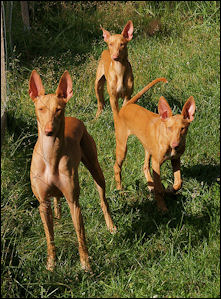ANCIENT EGYPTIAN SPORTS AND RECREATION

jugglers Egypt seemed to have no organized sports like Greece. Paintings depict wrestling matches as a battle of a superior over a weakling, not a match of equals. Men sometimes engaged in tug of wars and women played the vine game. Hieroglyphics from 4000 B.C. show the spread of boxing throughout the Nile. Tomb painting between 3400 and 1500 B.C. have images of running, swimming, rowing, and archery.
The Egyptians, Greeks and Romans played ball games. Hockey is one of the oldest stick and ball games. Early forms of hockey were played in ancient Egypt, Greece and Persia. Bowling evolve independently in Egypt, Polynesia and Germany. The ancient Egyptians played a game that was similar to modern bowling. Implements for a game similar to bowling were found in the tomb of a child buried around 5200 B.C.
Magic as a form of entertainment was known to the Egyptians, Greeks and Romans. A magical invocation from the New Kingdom funerary vase read: "You who come to disturb, I shall not let you disturb! You who come to strike, I shall not let you strike!"Book: “Magic in Ancient Egypt” by Geraldine Pinch, a professor of Egyptology at Cambridge University.
Categories with related articles in this website: Ancient Egyptian History (32 articles) factsanddetails.com; Ancient Egyptian Religion (24 articles) factsanddetails.com; Ancient Egyptian Life and Culture (36 articles) factsanddetails.com; Ancient Egyptian Government, Infrastructure and Economics (24 articles) factsanddetails.com
Websites on Ancient Egypt: UCLA Encyclopedia of Egyptology, escholarship.org ; Internet Ancient History Sourcebook: Egypt sourcebooks.fordham.edu ; Discovering Egypt discoveringegypt.com; BBC History: Egyptians bbc.co.uk/history/ancient/egyptians ; Ancient History Encyclopedia on Egypt ancient.eu/egypt; Digital Egypt for Universities. Scholarly treatment with broad coverage and cross references (internal and external). Artifacts used extensively to illustrate topics. ucl.ac.uk/museums-static/digitalegypt ; British Museum: Ancient Egypt ancientegypt.co.uk; Egypt’s Golden Empire pbs.org/empires/egypt; Metropolitan Museum of Art www.metmuseum.org ; Oriental Institute Ancient Egypt (Egypt and Sudan) Projects ; Egyptian Antiquities at the Louvre in Paris louvre.fr/en/departments/egyptian-antiquities; KMT: A Modern Journal of Ancient Egypt kmtjournal.com; Ancient Egypt Magazine ancientegyptmagazine.co.uk; Egypt Exploration Society ees.ac.uk ; Amarna Project amarnaproject.com; Egyptian Study Society, Denver egyptianstudysociety.com; The Ancient Egypt Site ancient-egypt.org; Abzu: Guide to Resources for the Study of the Ancient Near East etana.org; Egyptology Resources fitzmuseum.cam.ac.uk
Hunting: the Royal Sport of Ancient Egypt

According to a 1955 Sports Illustrated article “Egyptian artists, through the many centuries of great empire under the Pharaohs in the Nile Valley, created indisputable masterpieces, not a few of which depicted sports. Many of them suffered the depredations of time and man and no longer remain to be admired. In time they cover several eras. The little painting, Birds in an Acacia Tree, dates from about 1900 B.C. The painting of the youthful King Tut'ankhamun was done about 3,300 years ago. The fine hunting and fishing scenes are of an earlier period. Yet in each, one finds the same magnificent colors, the flawless sense of composition and the decorative richness of stylization. These are paintings of genre type, biographical in nature. They tell of pleasures enjoyed in earthly life, to be continued in life beyond the grave. The animals, birds and fish are among the classic wildlife paintings of all time. [Source: Sports Illustrated, September 26, 1955]
“1) "Tut' Ankhamun Hunting Lions" a decoration from the lid of a box found in the young Pharaoh's tomb, is a scene of magnificence and violence. Papyrus thickets on the banks of the Nile were fine hunting and fishing grounds for elite of Thebes, who made a day of sport into a family outing 2) "Fishing and Fowling in the Marshes" shows the use of throwing stick and spear. At left the hunter holds live birds as decoys while a trained cat flushes the birds. 3) "Hunting Wild Fowl in the Marshes" again illustrates the throwing stick, the live decoys and the trained cat. The sportsman, accompanied by his wife and daughter, has nonchalantly draped lotus flowers over his shoulder, while his little girl keeps him from falling off the reed boat by hanging onto his leg.”
Gardens of the Pharaohs
In 2011, the Rijksmuseum van Oudheden Museum in the Netherlands hosted an exhibition called Gardens of the Pharaohs that showcased the flora of ancient Egypt. Visitors discovered what plants, trees, flowers, and crops grew in the age of the pharaohs. The museum’s collection includes not only dried plant remains from thousands of years ago, but also pictures of plants and trees on a huge variety of objects: wall reliefs, mummy cases, jewellery, amulets, and drinking bowls. [Source: The Rijksmuseum van Oudheden Museum, Nederlands, March 9, 2012 \~/]

Model house with a garden
According to the Rijksmuseum van Oudheden Museum: “The flora of ancient Egypt was highly diverse. Over the centuries, the natural environment was replaced by a cultural landscape in which all kinds of exotic species were cultivated. Some were grown for food, of course, and many were used to treat diseases and other medical conditions: trees, bushes, produce, fibre crops, herbs (medicinal or otherwise), and ornamental flowers could all serve medical purposes. Agriculture was central to Egyptian life. Farmers made up a large part of the population, and canals, basins, and dikes provided permanent irrigation. \~/
“The wealthy Egyptian elite related to nature in a very different way from the impoverished farmers. In their circles, it was important to flaunt your status. Their ideal was to own an estate surrounded by a shady walled garden full of palms, sycamores, figs, perseas, Christ-thorns, willows, and other trees. There was almost always a pergola covered with grape vines, and a pond full of water plants formed the centre of these orderly, geometric gardens. Gardens of this kind could also be found surrounding the temples of the gods, and sometimes in front of the monumental tombs cut into the rocks. One site that vividly illustrates the Egyptians’ fascination with plants and flowers is the ‘botanical garden’ in the Temple of Karnak. In a series of chambers, artists carved wall reliefs depicting exotic plants and animals that the pharaohs had brought back to Egypt from their foreign campaigns.” \~/
The Egyptians grew roses. They produced the Egyptian rose, now called the cabbage rose. In Egyptian art, gardens were often the setting for love and romance.
Ancient Egyptian Games
Dice, identical to ones in use today, were found in Egyptian tombs dating back to 2000 B.C. Almost all the ancient civilizations used dice, which developed from astragali — six sided bones, with four flat sides, that came from the ankle bones of hoofed animals. Astragali were used in board games by Egyptians, possibly as early as 3500 B.C. The bones from sheep were most commonly used. Those from antelope were particularly prized.

Egyptian snake game
In ancient times board games were closely linked to divination rituals and battle planning. The game of checkers is derived from a wartime prognostication dated to around 2000 B.C. Examples of the game have been found in tombs. Early versions of the game had "enemy" prices, "captures," and "hostile" moves and checkered matrix playing boards. A wall painting from Thebes from 1600 B.C. shows Ramses II playing an early form of checkers with a woman.
Casey Boone of Minnesota State University, Mankato wrote: “Ancient Egypt had games of all kinds, some for fun and entertainment and the others for fitness. Samples of these games have been found in drawings located in the tombs at Saqqara, plus many others. These pyramids were built nearly 2600B.C. and believe it or not we still play some of these games to this day. As well as pictures, board games have also been found in tombs from the same time period. Many of the fitness type games depicted in paintings are of common games such as hockey, which used long palm tree branches for sticks and a puck made from stuffed papyrus in between two pieces of leather. There are also pictures of various types of games that use handballs. [Source: Casey Boone, Minnesota State University, Mankato, ethanholman.com, The Game of Senent, and, Dogs and Jackals by Catherine Soubeyrand gamecabinet.com; Games of Egypt ipl.org +]
“Various types of board games have been discovered such as Dogs and Jackals, Senet or Seega, and others such as 20-squares a similar type of game called 30 and 50 squares. Dogs and Jackals games and pieces have been found in tomb of Reny-Seneb. It’s board was made of wood, ebony and ivory and shaped like a piece of furniture and roughly measuring 15x10cm. It had 4 animal carved legs and the board was made of ivory with a palm tree carved into it with fifty five holes. There were drawers that held the ebony pawns that looked like a jackal and a dog’s head on a stick. Three coins were used to determine movements of the pieces on the board and the first person with all pieces at the end won the game. +\
Senet
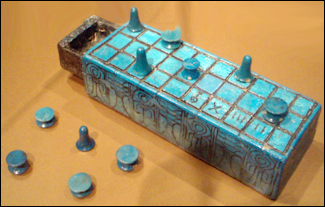
Senet board game “ Senet” is a chess-like board game played at least 4,300 years ago. Players moved five ivory and stones pieces around a papyrus board. A version of the game was found in the tomb of King Tutankhamun (1350 B.C.). In the Tomb of Nefertari there is an image of Nefertari playing it in her tent. Senet is associated with evil and witchcraft and is mentioned as a talisman in the “ Book of the Dead” that is supposed to free the soul of the dead and help on their journey to the afterlife.
Casey Boone of Minnesota State University, Mankato wrote: “Senet is another board game that has been found. One of these games was found in the tomb of Hesy along with painting of it and how to play. The rules of this game were very complex. It consisted of a board with 30 holes, 3 rows and 10 columns. Most of the games used 7 pawns, sticks or knucklebones for each of the two players but some only had 5. During the New Kingdom, the game of Senet had acquired a religious and magical meaning which symbolized the passage of the deceased through the netherworld with his resurrection dependant upon his/her ability to win the game. Since boards games of all quality have been discovered it is needless to say that the games were played by all classes of people in Ancient Egypt.”[Source: Casey Boone, Minnesota State University, Mankato, ethanholman.com, The Game of Senent, and, Dogs and Jackals by Catherine Soubeyrand gamecabinet.com; Games of Egypt ipl.org +]
The tomb of Tutankhamun (King Tut) contained a number of senet gaming boards. Robert Partridge of the BBC wrote: “Senet game: The rules of the game are not certain, but it was for two players, whose aim was to knock their opponent off the board. The number of squares moved was decided by throwing sticks (used like dice today). Clearly Tutankhamun was a keen player and this small version is a 'travelling set' made of painted ivory. [Source: Robert Partridge, BBC, February 17, 2011]
On the rules of senet, J. A. Storer of Brandeis University wrote: A) Start: Each player has 5 pieces, initially placed alternating on squares 1 to 10. B) Move: Players alternate throwing a set of 4 two sided paddles to move forward: 1 white side up = move 1 square and throw again; 2 white sides up = move 2 squares; 3 white sides up = move 3 squares; 4 white sides up = move 4 squares and throw again; 4 black sides up = move 6 squares and throw again C) Attack: Landing on an opponent's piece is an "attack", and you exchange places; you may not land on your own pieces. [Source: J. A. Storer, Brandeis University cs.brandeis.edu/~storer
Restrictions: FIRST MOVE: First throw of the game must move the piece on square 10. SAFETY: Squares 15, 26, 28, 29 cannot be attacked. DEFENSE: Two or more consecutive opponent pieces cannot be attacked. BLOCKADE: Three or more consecutive opponent pieces cannot be passed; however, blockades may not turn corners (10 to 11 or 20 to 21). TRAP: Land on 27 and go back to 15 (or the first empty square before it). EXIT: You may not move past 30. A piece on 30 can be removed at the start of your turn if all of your other pieces are out of the first row. NO MOVE: If you can't move forward, you must move backward (according to the same rules). If no move is possible your turn ends. Win: You win by removing all of your pieces.
Ancient Egyptian Toys
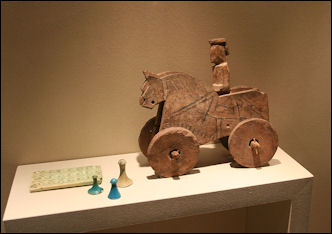
a toy There is evidence that Egyptian children played marbles 5000 years ago ( rounded semiprecious stones buried with a child around 3000 B.C., in Nagada Egypt). Marbles and knucklebones from dogs and sheep were used by adults in divining rituals. Rock, Scissors, Paper was played by the Egyptians and Romans. An Egyptian painting dated to 2000 B.C. shows a finger game like it being played.
Children in ancient Egypt, Greece and Rome made hoops from dried and stripped grapevines and rolled them down the street with a rod. Rattles made with dried gourds filled with clay balls or pebbles were discovered in children's tombs dated at 1360 B.C. They were shaped like birds, pigs and bears. Rattles were also used in ancient rituals to scare off evil spirits. The earliest dolls were images and idols of gods. Playing with idols was considered sacrilegious so the first true dolls were model or ordinary people played with by children. Early females dolls had breasts and male dolls had penises.
Pets and Wild Animals in Ancient Egypt
The ancient Egyptians kept pets. Pet cats date back to ancient Egypt. Dogs go back thousands of years before that. The Egyptian may have succeeded in domesticating cranes, ibex, gazelles, oryx and baboons. Bas reliefs show men trying to tame hyenas by tying them up and force feeding them meat.
Robert Partridge of the BBC wrote: “'Man's best friend' was considered not just as a family pet, but was also used for hunting, or for guard duty, from the earliest periods of Egyptian history. Pet dogs were well looked after, given names such as 'Blackey' or 'Brave One', and often provided with elaborate leather collars. The mummy of a dog, probably a royal pet; was found in a royal tomb in the Valley of the Kings. [Source: Robert Partridge, BBC, February 17, 2011]

Pet cheetah in Ancient Egypt
“Cats were kept to protect food stores from rats, mice and snakes, and were kept as pets. They are shown in paintings beneath their owners' chairs, or on their laps. Egyptian cats resembled modern tabby cats. The Egyptian name for cat is 'miw'. Cats also had a symbolic or religious meaning, as represented by the goddess Bastet, and in later periods of Egyptian history cat mummies were used as offerings to the gods.” |::|
The Egyptians were fond of cheetahs and kept herds of gazelles and antelopes. Oryxes and other kinds of antelope were kept as household pets. Even though the Egyptians may have tamed elephants there is no evidence they were domesticated like elephants in ancient Carthage.
Elephants in elaborate tombs were found in cemetery in Hierakonpolis, dated to 3500 B.C. One of the elephants was ten to eleven years old. That is the age when young males are expelled from the herd. Modern animals trainers say elephants at that age are young and inexperienced and can be captured and trained.
Cats in Ancient Egypt
Domesticated cats were present in ancient Egypt at least as early as 2000 B.C. So strong was the Egyptian love of cats that laws were established protect them from injury and death. Cats were mummified, buried in bronze coffins, and honored with elaborate funerals and a period of mourning.
The Egyptians produced lovely sculptures of cats. They were associated with the goddess Bastet. The belief that cats have nine lived is believed to have originated in Egypt based on the fact that cats can survive long falls. There were temples for Bastet, where mummified cats were left as offerings and kittens were bred by the thousands to meet the demand or offerings.
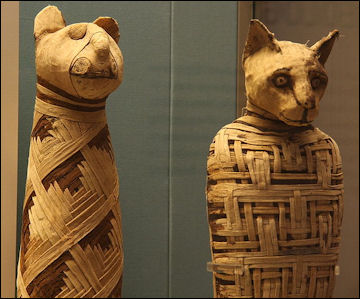
cat mummies Herodotus wrote that cats were considered so important that exporting them was illegal and killing one was a crime punishable by death. Owners of cats that died naturally were required to shave off their eyebrows.
Cats are believed to have been domesticated around 3000 B.C. to get rid of grain-eating rodents. The first domesticated cats are believed to have been African wild cats, small pale yellow creatures with black feet.
Egypt's most well known cat is the sphinx. Cats were "mummified in the millions" and buried as offerings. Priests carefully watched over temples cats. Their movements were sources of omens. In the 19th century so many mummified cats were exhumed that they were shipped to Britain as ballast, then ground into fertilizer."
Lions were said to accompany the pharaohs in battle and were give names like “Slayer of his Foes.” Killing a lion was regarded as an act of extraordinary bravery. Inscriptions describe the breeding and burial of lions. Thus far only one lion mummy has been found.
See Animal Mummies
Dogs in Ancient Egypt
Jarrett A. Lobell and Eric Powell wrote in Archaeology magazine, “The ancient Egyptians also cherished their dogs, not only as deities ("The Dog Catacomb"), but also as companions in this life — and the next. A mummy of a small dog that dates to the fourth century B.C. was found in the sacred Egyptian city of Abydos in 1902 alongside that of a man identified on his coffin as Hapi-Men. Both mummies are now in the University of Pennsylvania Museum of Archaeology and Anthropology. Hapi-Men and his companion, "Hapi-Puppy," were recently part of a project to reexamine several mummies from the museum's collection. Hapi-Puppy was taken to the University of Pennsylvania Hospital for a CT scan that confirmed he was indeed a dog (not a cat, as was also thought possible.) [Source: Jarrett A. Lobell and Eric Powell, Archaeology magazine, September/October 2010]
According to anthropologist Janet Monge, who led the scan study, Hapi-Puppy died at about two years of age, more like an adolescent than a baby, and had the same size, stockiness, and power of a Jack Russell terrier. "Hapi-Men must have loved his dog, and after his death, it seems that the dog pined away and died soon enough to have been mummified and buried with his master," says Salima Ikram of the American University in Cairo. According to Ikram, this practice was not uncommon. "There are much earlier Middle Kingdom (2080-1640 B.C.) tombs that depict a man and his dog, and both are named so that they can survive into the afterworld together," she says.
Greyhounds in Ancient Egypt
Pharaoh hounds Greyhounds are regarded as the world's oldest breed of dog along with the dingo, New Guinea singing dog, and African basenji. They were pictured in mural from a settlement in Turkey dating to 4000 B.C. By some reckonings the oldest dog breed, the saluki, is thought to have emerged in 329 B.C.
Greyhounds were raised and bred by Egyptians and were pictured in ancient Egyptian tomb paintings. The oldest reference to a greyhound is a carving of the Tomb of Amten in the Nile Valley, dated between 2900 and 2751 B.C. It shows three images greyhound or greyhound-type dogs. Two are attacking deer and one is attacking an animal that looks like a wild goat.
Extremely fast and maneuverable, greyhounds were used for hunting animals such as gazelles and wolves and coursing hares. Over the centuries they have been used to pursue all kinds of animals including deer and foxes. Their natural prey is hares.
Greyhounds were linked with royalty, who treated their dogs so well that ordinary people resented them because they were treated better than people. The dogs of some pharaohs had 2,000 attendants.
Dog Catacombs in Ancient Egypt
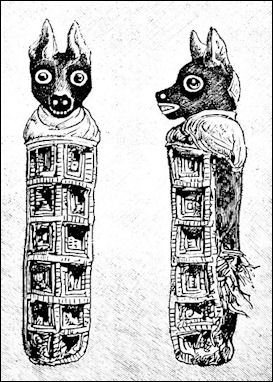
dog mummies Paul Nicholson wrote in Archaeology magazine, “ In 1897, French Egyptologist Jacques De Morgan published a map of the necropolis of Saqqara, the burial place of Egypt's first capital city, Memphis. The map includes the only known plan of the "Dog Catacombs" at the site, but no information about the date or circumstances of their discovery. In fact, virtually nothing is known of these catacombs. [Source: Paul Nicholson, Archaeology magazine, September/October 2010. Nicholson is Director, Cardiff University-Egypt Exploration Society Mission to the Dog Catacombs]
Last year, I began a Cardiff University-Egypt Exploration Society mission to the catacombs, which date from the Late and Ptolemiac Periods (747-30 B.C.), the last dynasties before the Romans conquered Egypt. We hope to learn if the De Morgan plan is accurate and see if we can find any clues to the early history of the catacombs' exploration. Right now we are completely remapping the catacombs and looking for clues to the circumstances of their discovery, such as travelers' graffiti and lamps from earlier explorers.
The first catacomb, one of two main locations for dog burials at Saqqara, was the subterranean element of the Temple of Anubis — the jackal-headed god of the dead — a little to the south. According to the map, the temple had a long corridor that was probably a ceremonial route and numerous shorter tunnels on each side filled with thousands of mummified dogs and animal remains. The majority of these animals would have been votive offerings by pilgrims who hoped that the deceased animals would intercede with the deity on their behalf. Others, however, may have been representatives of the god and lived within the temple compound. Some of the dogs that were buried in special niches in the tunnel walls, rather than being piled in the great mass of remains, may be those animals. Many seem to have lived to considerable age, while other animals met their deaths after only a few months.
But the question remains — are they really all dogs, as the catacombs' name suggests? Preliminary examination by the American University in Cairo's Salima Ikram, the project's animal bone specialist, suggests that many of the mummified animals, now mostly lacking their wrappings, are indeed dogs. But according to Ikram, "Anubis was a kind of super-canid, so it is likely that jackals, foxes, and maybe even hyenas were mummified and given as offerings to Anubis." There is also still debate about exactly what kind of canid Anubis was meant to represent. Although the concept of dog breeds is a modern one, we hope to discover more information about the species, types, ages, and genders of the animals in the catacombs to understand how the god was perceived.
Did the Ancient Egyptians Worship Animals

cat killing the demon Apep
According to Minnesota State University, Mankato: “Some of the most interesting and misunderstood information about the Ancient Egyptians concerns their calendarical and astrological system. Of the greatest fallacy about Ancient Egypt and it's belief in astrology concerns the supposed worship of animals. The Egyptians did not worship animals, rather the Egyptians according to an animals astrological significance, behaved in certain ritualistic ways toward certain animals on certain days. For example, as is evidenced by the papyrus Cairo Calendar, during the season of Emergence, it was the advisement of the Seers (within the priestly caste), and the omens of certain animals they saw, which devised whether a specific date would be favorable or unfavorable. +\ [Source: Minnesota State University, Mankato, ethanholman.com +]
“The basis for deciding whether a date was favorable or unfavorable was based upon a belief in possession of good or evil spirits, and upon a mythological ascription to the gods. Simply, an animal was not ritually revered because it was an animal, but rather because it had the ability to become possessed, and therefore could cause harm or help to any individual near them. It was also conceived of that certain gods could on specific days take the form of specific animals. Hence on certain days, it was more likely for a specific type of animal to become possessed by a spirit or god than on other days. The rituals that the Egyptians partook of to keep away evil spirits from possessing an animal consisted of sacrifice to magic, however, it was the seers and the astrologers who guided many of the Egyptians and their daily routines. Hence, the origin of Egyptians worshipping animals, has more to do with the rituals to displace evil spirits, and their astrological system, more so than it does to actually worshipping animals.” +\
Animal Cults in Ancient Egypt
Two kinds of cult animal existed in ancient Egypt: 1) animals associated with a given deity that lived in a temple and were ceremonially interred; 2) creatures killed and mummified to act as votive offerings. The former existed in the earliest times, while the latter date from the Late Period (712–332 B.C.) and later. Aidan Dodson of the University of Bristol wrote: “While there continues to be debate over precise definitions, it seems broadly agreed that cult animals in Egypt fall into two distinct groups. The first are specific specimens of a given species that were held to be an earthly incarnation of a particular deity, or at least in whom the deity could become incarnate. Resident in the god’s temple, they would be the subject of a suite of rituals, and would often receive elaborate treatment at death. These will be referred to as “Sacred Animals.” The other group are representatives of a species whose embalmed remains could be offered by pilgrims coming to seek the favor of a deity (“Votive Animals”). There would normally only be one example of the first kind at a time; deposits of the second kind could run into the hundreds or even thousands within a short period of time. Animals were also, of course, employed in temples as sacrificial victims. [Source: Aidan Dodson, University of Bristol, UCLA Encyclopedia of Egyptology 2009, escholarship.org ]

“Many of the gods and goddesses of ancient Egypt had animal forms. Obvious examples are the cat of Bastet, the ram of Khnum, the cow of Hathor, and the falcon of Horus, which reflected the deities’ iconic theriomorphic forms. However, Amun could also appear in the form of a goose, while a considerable number of deities had a bovine form. It is from the latter that our best evidence for the ritual that might surround a sacred animal comes. On the other hand, while it seems that bulls were allowed to live out their natural lives (although cf. below), other creatures were more ephemeral, for example a new falcon of Horus was installed each year at Edfu.
“A multiple burial-place...has been uncovered for the rams of Khnum on Elephantine, and remains deriving from such an installation have been found for the rams of Banebdjed at Mendes. It is likely that the baboons buried in niches in the walls of the catacombs at Tuna el-Gebel represent a succession of sacred animals of Thoth. However, the latter also contain very large numbers of embalmed ibises, which are clearly representatives of the other variety of cult-animal, the votive creature.
“Judging by the uniformity of their age at death and standardized treatment, it seems clear that votive animals were bred specifically for the purpose on an industrial scale, killed when they reached a given size, and then mummified for sale to pilgrims at a number of sacred places around Egypt. The range of treatments and elaboration of wrappings suggests the production of something for every pocket. It seems that they were deposited in a temple by pilgrims – perhaps with a prayer to the god whispered in its ear – and when the temple became cluttered, they were taken to an appropriate burial place. At Abydos, ibis mummies were buried within the confines of the 2nd Dynasty Shunet el-Zebib enclosure, but subterranean arrangements are found at Tuna, Western Thebes, Tell Basta, and various other locations. Most important of all, however, are the series of catacombs at Saqqara.
“As elsewhere, the catacombs of the Sacred Animal Necropolis at Saqqara seem to have been begun during the Late Period, and adjoin the aforementioned burial of the Mothers of Apis. They form part of a complex of temples and shrines located some 700 meters northeast of the Serapeum, together with major enclosures on the desert edge, and an as-yet little known set of chapels north and south of the Serapeum. Separate catacombs exist of ibises, baboons, falcons, and dogs, while cats were interred in extensions of New Kingdom tomb chapels on the edge of the Saqqara escarpment. In addition to literally millions of mummified animals and birds, a number of deposits of bronze divine figures were also made in the Sacred Animal Necropolis, clearly also votives brought by pilgrims.
Image Sources: Wikimedia Commons, The Louvre, The British Museum, The Egyptian Museum in Cairo
Text Sources: UCLA Encyclopedia of Egyptology, escholarship.org ; Internet Ancient History Sourcebook: Egypt sourcebooks.fordham.edu ; Tour Egypt, Minnesota State University, Mankato, ethanholman.com; Mark Millmore, discoveringegypt.com discoveringegypt.com; Metropolitan Museum of Art, National Geographic, Smithsonian magazine, New York Times, Washington Post, Los Angeles Times, Discover magazine, Times of London, Natural History magazine, Archaeology magazine, The New Yorker, BBC, Encyclopædia Britannica, Time, Newsweek, Wikipedia, Reuters, Associated Press, The Guardian, AFP, Lonely Planet Guides, “World Religions” edited by Geoffrey Parrinder (Facts on File Publications, New York); “History of Warfare” by John Keegan (Vintage Books); “History of Art” by H.W. Janson Prentice Hall, Englewood Cliffs, N.J.), Compton’s Encyclopedia and various books and other publications.
Last updated September 2018

